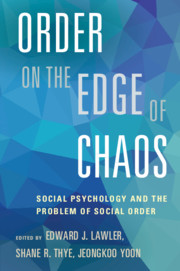Book contents
- Frontmatter
- Contents
- List of Contributors
- Preface
- 1 Social Psychology of Social Order: An Introduction
- 2 The Evolutionary Biology and Sociology of Social Order
- 3 Social Rationality and Weak Solidarity: A Coevolutionary Approach to Social Order
- 4 An Integrative Theory of Action: The Model of Frame Selection
- 5 The Center Cannot Hold: Networks, Echo Chambers, and Polarization
- 6 Social Exchange and Social Order: An Affect Theory Approach
- 7 Institutions, Trust, and Social Order
- 8 Identity Verifi cation and the Social Order
- 9 Identities, Roles, and Social Institutions: An Affect Control Account of Social Order
- 10 The Gender Frame and Social Order
- 11 Status, Power, and Social Order
- 12 Interaction Order: The Making of Social Facts
- 13 The Arts of Together: Social Coordination as Dyadic Achievement
- 14 Dignity as Moral Motivation: The Problem of Social Order Writ Small
- 15 The Legitimacy of Groups and the Mobilization of Resources
- Commentary: Contrasts and Complementarities
- Index
- References
1 - Social Psychology of Social Order: An Introduction
Published online by Cambridge University Press: 05 December 2015
- Frontmatter
- Contents
- List of Contributors
- Preface
- 1 Social Psychology of Social Order: An Introduction
- 2 The Evolutionary Biology and Sociology of Social Order
- 3 Social Rationality and Weak Solidarity: A Coevolutionary Approach to Social Order
- 4 An Integrative Theory of Action: The Model of Frame Selection
- 5 The Center Cannot Hold: Networks, Echo Chambers, and Polarization
- 6 Social Exchange and Social Order: An Affect Theory Approach
- 7 Institutions, Trust, and Social Order
- 8 Identity Verifi cation and the Social Order
- 9 Identities, Roles, and Social Institutions: An Affect Control Account of Social Order
- 10 The Gender Frame and Social Order
- 11 Status, Power, and Social Order
- 12 Interaction Order: The Making of Social Facts
- 13 The Arts of Together: Social Coordination as Dyadic Achievement
- 14 Dignity as Moral Motivation: The Problem of Social Order Writ Small
- 15 The Legitimacy of Groups and the Mobilization of Resources
- Commentary: Contrasts and Complementarities
- Index
- References
Summary
A person dropped into downtown Manhattan in the middle of the day for the first time would face an unpredictable, disorderly world: fast-walking people dodging around one another on sidewalks; pedestrians and cars contesting for street access at every corner; bicyclists running red lights; trucks double parking and blocking access to and from sidewalks; rampant herdlike jaywalking; horns honking; cabbies shouting; sirens of fire engines and ambulances blaring; and ever-present construction projects posing obstructions to most everybody. Yet, it would not take long for our visitor to sense a semblance of social order – in the form of repeated, predictable patterns of behavior. This patterned local world exists “on the edge of chaos,” with order and predictability eroding and re-emerging moment-to-moment and situation-to-situation (see also Lawler 2013). Very soon this immediate, local social order would reveal both resilience and dynamism. This is a fundamental insight of sociological theories of social psychology on the emergence and maintenance of social orders (e.g., Rawls 2004; Turner 2007; Burke and Stets 2009; Lawler, Thye, and Yoon 2009; Fine 2012; Ridgeway 2011). Sociological social psychologists (micro-sociologists) construe patterns of regularity as social constructions that people create and sustain under conditions of uncertainty, instability, or tension.
The regularity, repetition, and predictability of everyday social lives are constitutive of social orders, at both macro and micro levels (see Collins 1981). However, without the “edge of chaos” or ever looming prospect of disorder, social order as such would draw little interest or have little meaning. Repetitive, predictable patterns of behavior are meaningful to people because of the contrast with disorder, real or hypothetical. Repetitive patterns that constitute order enable people with vastly different social backgrounds, conflicting cultural ideas or material interests, or diverse social affiliations to navigate close proximities, work around or take advantage of interdependencies, and produce joint goods of mutual value. To micro-sociologists, micro (local, immediate) orders are taken for granted; they are subtle, obdurate, pervasive, and often invisible features of social life (Maynard 2003; Fine 2012). People do not consciously observe or ponder social order unless it is somehow disrupted or threatened. By contrast, disorder and conflict are generally salient, discomfiting, and often stressful or threatening. There is a fundamental asymmetry in the ontological status of social order and social disorder.
- Type
- Chapter
- Information
- Order on the Edge of ChaosSocial Psychology and the Problem of Social Order, pp. 1 - 17Publisher: Cambridge University PressPrint publication year: 2015
References
- 2
- Cited by



